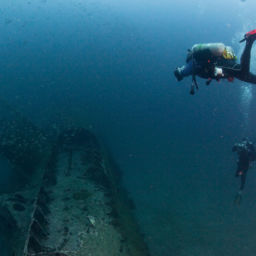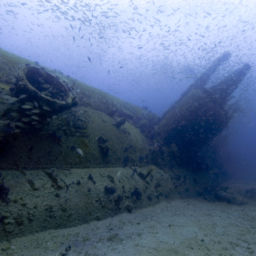From January to the end of August 1942, German U-boats attacked more than 285 vessels in North American waters. Just off coastal North Carolina, the remnants of many of these ships are scattered on the ocean floor. The remains of this little-known battlefield serve as the final resting place for 90 ships and nearly 1,700 men lost during the Battle of the Atlantic. Over the course of the battle, eight Allied convoy vessels, 78 merchant freighters and tankers and four German U-boats sank off North Carolina’s coast. Each shipwreck tells a unique story; today we visit the W.E. Hutton.
W.E. Hutton sinks
Launched on April 20, 1920, the tanker W.E. Hutton was originally named Portola Plumas. It was one of 15 standardized cargo ships delivered to the U.S. Shipping Board. The 435-foot (133 m) ship was driven by a single screw, triple-expansion engine using three Scotch boilers that could propel the vessel up to 10.5 knots. In 1923, Pure Oil Steamship bought the ship and renamed it W.E. Hutton and it began service as a petroleum tanker.
On its final voyage, W.E. Hutton set sail from Smith’s Bluff, Texas, making its way to Marcus Hook, Pennsylvania. On the night of March 18, 1942, the tanker carried 65,000 barrels of heating oil. It was transiting just 20 miles (32 km) southwest of the Cape Lookout Light Buoy, one of the most dangerous areas of the East Coast. Although U-boat threats were dire all along the U.S. coast, convoys had not yet become standard during this early phase of the war. Therefore, W. E. Hutton traveled unarmed and unescorted. With no other option, the captain followed the routing instructions and blacked out the ship.
German U-boat U-124 was operating in the same vicinity. It had just succeeded in destroying the tanker Papoose an hour earlier when it spotted W.E. Hutton. U-124 fired two torpedoes toward the unsuspecting tanker.
One torpedo missed, but the other hit the starboard bow. The W.E. Hutton crew sent a distress signal and set about lowering the lifeboats. Eight minutes after the first explosion, U-124 fired another torpedo toward the stationary tanker, and it struck amidships. An enormous explosion erupted, ignited the cargo, and engulfed the ship in a raging inferno. As the crew hastily abandoned ship, 15 men made it into two lifeboats and eight more into two rafts. Sadly, several crew members reported seeing some of their crew mates on fire and jumping into the sea.
The ship sank within an hour of the initial attack. At daybreak, the survivors consolidated into a single raft and began rowing for shore. At 10:35 Eastern War Time, the British merchant vessel Port Halifax picked up the survivors and took them to Savannah, Georgia. Of the 36-man crew, 13 were lost.
Diving W.E. Hutton
The wreck of W.E. Hutton rests in 125 feet (38 m) of water off Cape Lookout near Beaufort, North Carolina. The wreckage is broken into multiple sections, with two main relief areas (bow and stern sections) separated by about 145 feet (44 m). Both sections rest upside down and orient northeast to southwest, bow to stern. The bow section measures approximately 203 feet in length (62 m) and 40 feet (12 m) at the beam. The stern section of the wreckage is around 208 feet long (63 m) and 55 feet (17 m) at the beam. Divers experience a mostly contiguous wreck site with the boilers, engine remains, two anchors at the bow still in the hawse pipes, and tangled metal visible.
Today, the wreck is a popular dive site where divers cannot only experience World War II history, but also see beautiful underwater marine life. Small fish are frequent visitors of the wreck site, and sand tiger and bull sharks also occasionally visit.
“Even though parts of the vessel remains are upside down, there are so many unique spots to identify machinery as well as observe vibrant marine life,” says NOAA maritime archaeologist and diver Will Sassorossi. “The bow section in particular is quite interesting as part of it sits upright, on its keel, directly alongside a section of overturned hull.”
Through the years, the dive community questioned the identity of this wreck, as well as others nearby. With the large number of shipwrecks so close together and the “fog of war” effect, it is understandable why confusion exists. Since 2008, with the assistance of the local dive community and avocational researchers, NOAA positively identified other misidentified wreck sites including San Delfino, Ario, and Papoose. As of 2016, after extensive survey work, NOAA believes the wreck site once thought to be the merchant tanker Ario is in fact W.E. Hutton.
An expanded sanctuary
In an effort to honor the service and sacrifice of those lost during the Battle of the Atlantic, NOAA in 2019 will release a draft proposal to expand the boundaries of Monitor National Marine Sanctuary to include a nationally significant collection of shipwrecks that currently have little or no legal protection. The expansion would also establish the largest area designated as a World War II battlefield anywhere in the world. W.E. Hutton is one vessel included in the proposal.
To learn more about the proposal, click here.



















